Get your desired twin line welding hose from China, designed for safe and efficient gas and oxygen delivery during welding operations. Our hoses are durable, flexible, and reliable, ideal for industrial, workshop, or professional welding use. Perfect for distributors and bulk buyers seeking high-performance welding accessories.
Durable Construction – Made from high-quality rubber or PVC, our twin line welding hoses resist abrasion, pressure, and chemical damage, ensuring long-lasting performance in demanding welding environments.
Flexible & Easy Handling – The hoses are highly flexible, making them easy to maneuver during welding, reducing operator fatigue while maintaining smooth gas flow for precise welding results.
Safety Compliance – Our welding hoses meet international safety standards, ensuring secure oxygen and gas delivery, leak resistance, and reliable operation in industrial or workshop applications.
Twin Line Design – Equipped with dual channels for oxygen and fuel gas, the hoses simplify setup, enhance safety, and provide convenient gas management for welding tasks.
Wholesale & Custom Options – Available in bulk and various lengths, our twin line hoses can be customized to meet specific industrial, commercial, or workshop requirements for efficient gas delivery.
Delight your clients with Kingdaflex’s premium rubber twin welding hose, engineered for safe and efficient oxygen and fuel gas delivery. Our durable, flexible hoses meet stringent safety standards, ensuring reliable performance in diverse welding applications. Offer your clients a product they can trust for consistent and safe operation. Contact us for wholesale options.
We can produce hoses in various grades, including Grade R, Grade T, and Grade RM, to ensure compatibility with your chosen fuel gas. By using high-quality synthetic rubber, we guarantee the hose material is resistant to oil and flame, thereby providing maximum safety and longevity.
While the standard colors are red for fuel gas and green or blue for oxygen, we can customize the outer jacket with different colors. This can be useful for brand identification or for further distinguishing hoses in a complex workplace, helping to prevent cross-contamination or misuse.
We offer a range of inner diameters to suit different flow requirements and torch sizes. We can also provide any custom length you need, from short sections for small workshops to long runs for larger industrial applications, making sure your hose is the perfect fit for your setup.
We provide various fitting options, including brass or stainless steel nuts and nipples, to ensure a secure connection to your equipment. We can also pre-assemble the hoses with these fittings and protective spring guards, so your customized hose arrives ready to use, saving you time and effort.
Twin line welding hoses come in specific grades determined by their material composition and compatibility with various fuel gases. Choosing the right grade is a critical safety measure, as using an incompatible hose can lead to hose degradation, leaks, and potential accidents.
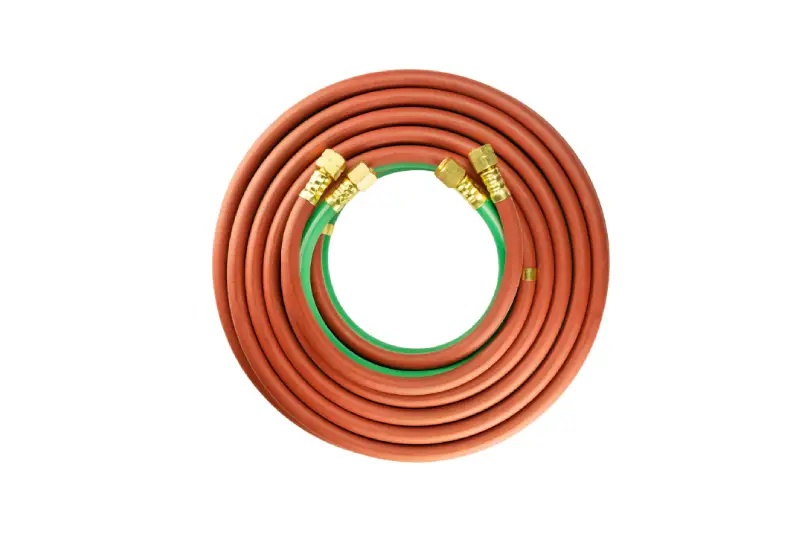
Twin welding hose Grade R is the standard for oxy-acetylene welding setups. This hose is made from synthetic rubber compounds compatible with acetylene gas but lacks resistance to oil and flame. This makes it the most economical option, but it is not safe to use with other fuel gases containing hydrocarbons, which would cause the hose to degrade.

Twin welding hose Grade T is the safest and most versatile choice. Made from high-quality rubber like chloroprene, it is resistant to both oil and flame. This makes it suitable for all fuel gases, including acetylene, propane, propylene, and natural gas. Its durability and all-purpose compatibility justify its higher cost for most welding applications.
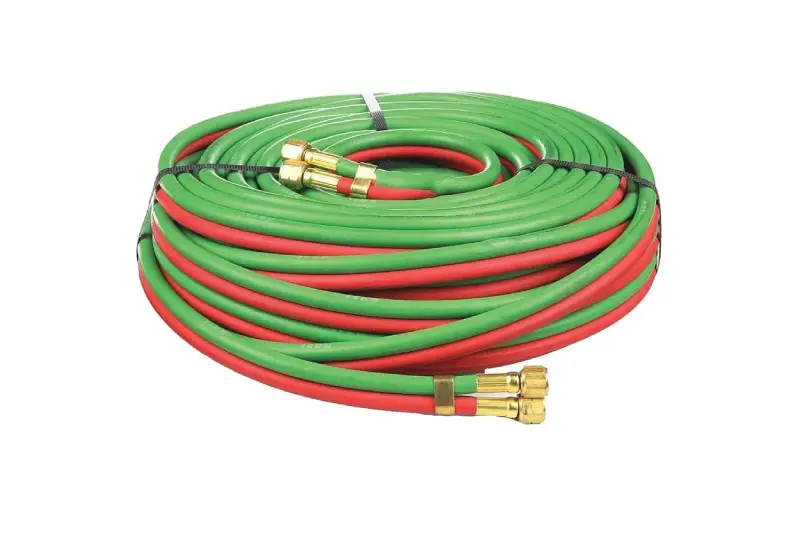
Twin welding hose Grade RM is a middle-ground option. Its inner tube material is not oil-resistant, limiting its use to acetylene and MPS gases. However, its outer cover is oil and flame-resistant, offering a level of protection against external hazards. It serves as a more economical alternative to Grade T for users with specific gas needs.
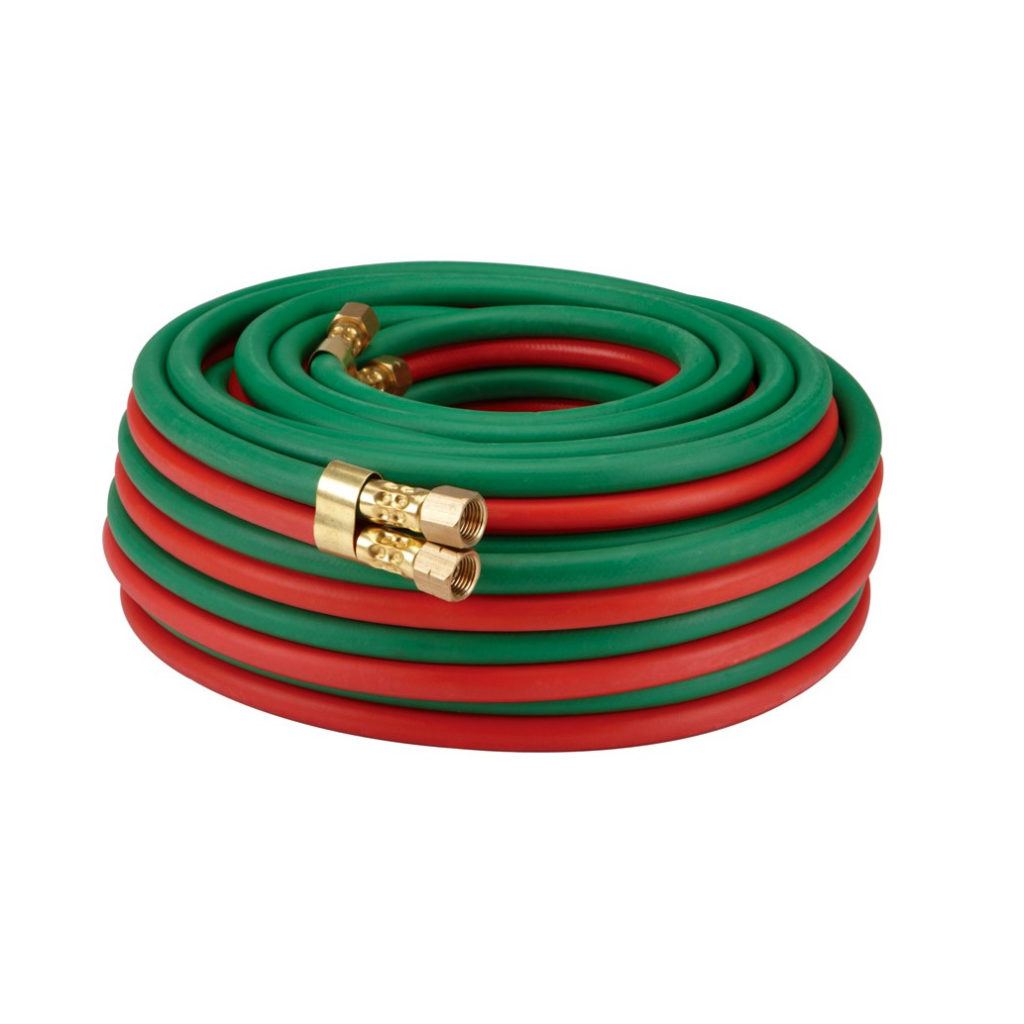
A rubber twin welding hose is a type of welding hose specifically designed to carry both fuel gas (like acetylene or propane) and oxygen simultaneously within a single rubber unit.
Key Characteristics:

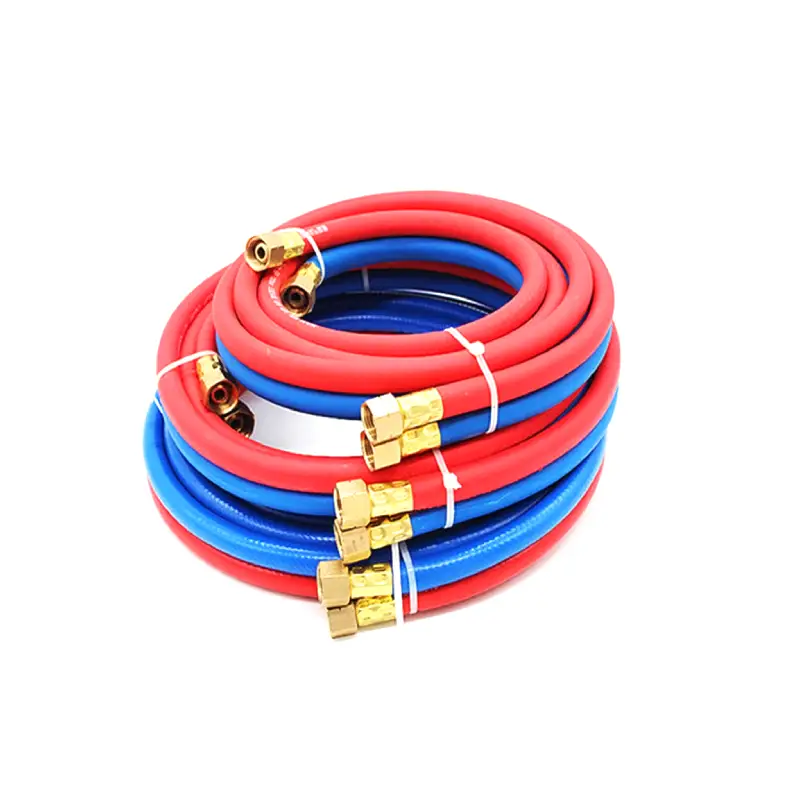
Lightweight and Flexible: PVC twin welding hoses are significantly lighter than their rubber counterparts, making them easier to handle and maneuver, which can reduce user fatigue during long welding sessions. They are also flexible, though they can stiffen in cold temperatures.
Cost-Effective: Generally, PVC hoses are more affordable to manufacture than rubber hoses, resulting in a lower purchase price for consumers. This makes them a great option for hobbyists or for applications where the hose won’t be subjected to the most extreme conditions.
Good Chemical Resistance: PVC has a natural resistance to many chemicals, oils, and UV radiation, which can extend the hose’s life in certain environments. This makes them a durable choice for a variety of work settings.
Temperature Limitations: A key disadvantage of PVC hoses is their limited temperature range. They can become brittle in very cold temperatures and may soften or warp when exposed to high heat, which can be a safety concern in a welding environment.
A rubber twin welding hose is a type of welding hose specifically designed to carry both fuel gas (like acetylene or propane) and oxygen simultaneously within a single rubber unit.
Key Characteristics:

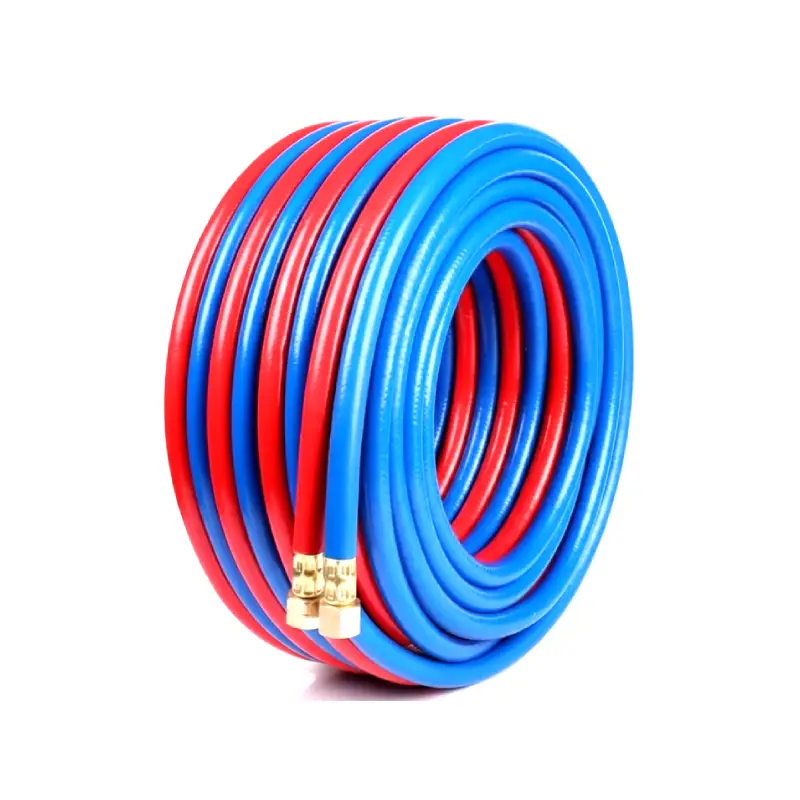
Durable Rubber Construction: These hoses are made from high-quality rubber compounds, providing flexibility, abrasion resistance, and long-lasting performance. By maintaining integrity under harsh conditions, they ensure consistent gas delivery for welding and cutting operations.
Braided Reinforcement: The hoses feature braided textile or synthetic fiber reinforcement. This layer enhances pressure resistance, prevents hose expansion, and improves durability, ensuring safe and reliable gas transfer in high-pressure welding applications.
Twin Line Design: The twin line design separates oxygen and acetylene pathways. By maintaining clear and isolated gas channels, the hoses reduce the risk of contamination, backflow, and ensure precise and safe gas supply.
High Pressure Resistance: These hoses are engineered to withstand high operational pressures. By maintaining flexibility and structural integrity, they provide reliable performance in demanding welding, cutting, and industrial applications.
Temperature and Chemical Resistance: The hoses resist heat, flames, and exposure to welding chemicals. By providing thermal and chemical stability, they enhance safety and extend service life, even in extreme working conditions.
A twin line welding hose is a specialized type of welding hose designed to carry both fuel gas (like acetylene or propane) and oxygen simultaneously within a single unit.
Twin line welding hoses are typically made from rubber.
Here’s a breakdown of the common materials:
Tube:
Reinforcement:
Cover:
This combination of materials ensures that the hose is durable, flexible, and safe for use in welding applications.
Twin line welding hoses are primarily used for delivering both fuel gas (like acetylene or propane) and oxygen simultaneously to welding torches and cutting equipment.
Here’s a breakdown of their common applications:
Essentially, any welding or cutting process that requires the simultaneous delivery of fuel gas and oxygen can potentially benefit from the use of a twin line welding hose.
Welding hoses must be able to withstand significant pressure.
Working Pressure: This is the maximum pressure the hose is designed to operate under during normal use.
Burst Pressure: This is the pressure at which the hose will rupture.
By adhering to these guidelines, you can ensure the safe and reliable operation of your welding equipment.
Welded pipes are generally not considered suitable for high-pressure applications due to the following reasons:
While welded pipes can be used in some high-pressure applications with careful design and rigorous quality control, seamless pipes are generally preferred for critical high-pressure applications due to their inherent strength and lack of a weld seam.
Note: The suitability of welded pipe for any specific application depends on factors such as the pressure rating, the type of fluid being transported, the operating temperature, and the specific welding process and quality control measures used.
Selecting the best twin welding hose is crucial for ensuring safe and efficient welding operations. The wrong hose can lead to leaks, reduced gas flow, and potentially dangerous situations. By considering several key factors, you can choose a twin welding hose that meets your specific needs and provides reliable performance.
Identify Your Gas Types and Pressure Requirements
First, determine the types of gases you will be using (e.g., oxygen and acetylene, or oxygen and propane) and their required operating pressures. Different gases have different pressure requirements, and your hose must be rated to handle these pressures safely. Ensure the hose you choose is compatible with the specific gases you intend to use to prevent material degradation and potential hazards.
Consider Hose Material and Construction
Twin welding hoses are typically made from rubber or PVC. Rubber hoses offer excellent flexibility and durability, especially in demanding environments. Look for hoses that meet industry standards like RMA Grade RM for oil resistance. The construction should include separate internal tubes for each gas bonded together, with a durable outer cover to protect against abrasion and weathering.
Evaluate Length and Diameter Needs
Select a hose length that provides sufficient reach for your welding tasks without being excessively long, which can lead to pressure drops. The inside diameter (ID) of the hose affects gas flow rate. Refer to your torch and regulator specifications to determine the appropriate ID for optimal performance. A correctly sized hose ensures adequate gas supply for efficient welding.
Check for Safety Standards and Certifications
Ensure the twin welding hose you choose meets relevant safety standards and carries certifications from recognized organizations (e.g., UL, CSA). These certifications indicate that the hose has been tested and meets specific safety and performance requirements. Look for clear markings on the hose indicating the gases it’s compatible with and its pressure rating.
Assess Durability and Environmental Resistance
Consider the conditions in which the hose will be used. If you work in environments with sharp objects, extreme temperatures, or exposure to chemicals and oils, choose a hose with a robust outer cover and materials designed to withstand these conditions. A durable hose will have a longer lifespan and provide more reliable service, ultimately saving you money and ensuring safer operations.